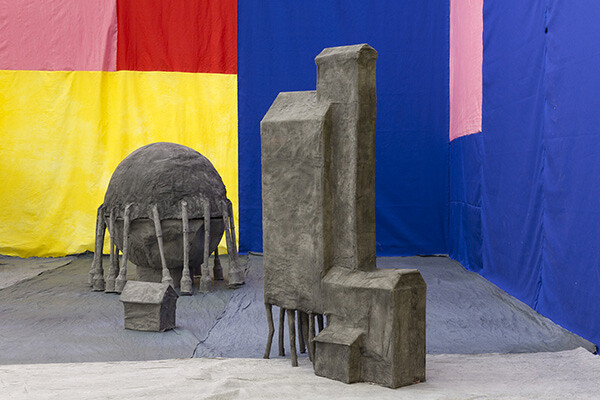“And here Alice began to get rather sleepy, and went on saying to herself, in a dreamy sort of way, ‘Do cats eat bats? Do cats eat bats?’ and sometimes, ‘Do bats eat cats?’ for, you see, as she couldn’t answer either question, it didn’t much matter which way she put it.”1 Adventures in Wonderland, cats and bats—or bisky bats and pussy cats, one could say, to quote from Edward Lear, another Victorian genius of rhyme2—abound in Marvin Gaye Chetwynd’s exhibition at Massimo De Carlo, Milan. This exercise in small surprises, hazy colors, odd creatures, and pensive stupor is the final chapter of an intense year of work for Chetwynd, marked by her first solo exhibition in a British institution (Nottingham Contemporary) and two others in London (at Sadie Coles and Studio Voltaire), besides other projects in France, Scotland, Poland, Austria, Australia, and the U.S. No performance was attached to this Milanese stop (while in 2008, for her debut at the gallery, Chetwynd orchestrated a frenzied Snail Race, with two teams of dressed-up contestants riding giant shells) and yet, despite the absence of live bodies and action, the artist is present.
Everything is overtly DIY, analog, hand-made. Chetwynd uses poor materials such as papier-mâché, outmoded technical supports such as canvas, and as little digital technology as possible. Even when she uses it, for instance with the green-screen effects in her film, she reveals the trick by overdoing it. In the age of over-professionalized “zombie abstraction,” overly post-produced seamless surfaces, and ever cleaner, sanitized, disposable, and consumerized works, Chetwynd allows herself enough mockery, sensuality, and disorder to make her art a liveable space of experience, rooted in the archaeology of happenings—think of Claes Oldenburg’s “Ray Gun Show” at Judson Gallery, New York, in 1960.
This show is, quite simply, a collage of works produced in 2014. The first room, lined in blue, pink, red, and gray textiles, like a DIY Mondrian prop from a school drama, displays a series of miniaturized architectures (Industrial Estate) in papier-mâché painted black, created by Chetwynd for the film Vision Verticale, staged at Le Consortium, in Dijon. From the same set also comes Corine’s Puppet Theatre—ladies and gents, welcome to the circus of space! On the first floor, longer strips of hand-dyed textiles hanging from the ceiling create a floating labyrinth, which came alive on the opening night, with visitors playing hide-and-seek. On the walls, at regular intervals, Chetwynd hung more funny characters in papier-mâché (Denis and Aliette; Corine and Baptiste; Monsters) and costumes (Bull Jumping Headdresses; Bull Jumping Dress), next to six new oil paintings from her classical series “Bat Opera” (2002–ongoing) devoted to the freakiest members of the mammalian family who can fly, echolocate, and groom themselves to keep their furs clean, like cats, by the way. The costumes reappear in the film King Must Die/Yoyo’s Caught Catting, the second episode of the trilogy Hermitos Children. The telepathic detective Joan Shipman—a Miss-Marple-meets-Bloomsbury circle cross-dressing clairvoyant interpreted by Joe Scotland, director of Studio Voltaire and Chetwynd’s longstanding friend and partner in crime—rescues her ex-husband Yoyo, who has been blackmailed by a gang of adepts of “catting,” an equivalent of dogging practiced by “female-dominated groups” in the proximity of “sea and waterways,” as the script explains. The group is linked to a nightclub that used to organize “elaborate events” of “extreme fantasy and twisted experimentation between consenting creative adults,” but which ran into trouble as soon as it started to “escalate spectacles.” The case is happily solved when Joan, who is also a debt counselor, suggests to charge an entry fee to the club, and then gain enough income to cover its costs. Ta-da.
Shot in Gozo, near Malta (an island famous for its carnival), as well as in Nottingham, London, Krakow, Sydney, Gothenburg, and Vienna, the film records family holidays and parties, crying kids and laughing friends, while incorporating footage of staged performances, dances, acted dialogues and scenes, cave dwelling and acrobatic bull leaping in a freewheeling mix. Whether Chetwynd’s year was dictated by the plot of Hermitos Children, or the other way round, is hard to guess, even backwards, since the artist blurs the lines between performance and documentation, action and out-of-action. She challenges the rules of surveilled self-exposure and selfie-ness dictated by social media by fictionalizing new roles for herself and creating new multiples of her public persona. During the film, one of the girls explains that she started to practice catting as “a reaction against smartphones.” She just wanted to be “spontaneous,” while others embraced it for the sake of “being outdoors, unobserved, with no strains.” Chetwynd’s sense of parody rules. I’ve admired her strategy of pitching bodypainting versus batpainting, the least collectible artwork versus the perfectly sellable precious item, to keep cats and bats afloat. “Twinkle, twinkle, little bat!/ How I wonder what you’re at!/ Up above the world you fly,/ Like a tea tray in the sky./ Twinkle, twinkle, little bat!/ How I wonder what you’re at!”3
Lewis Carroll, Alice’s Adventures in Wonderland (Project Gutenberg, 2008). http://www.gutenberg.org/files/11/11-h/11-h.htm. Last accessed January 11, 2015.
Edward Lear, Bisky Bats and Pussy Cats. The Animal Nonsense of Edward Lear (London: Bloomsbury Children’s Classics, 1998).
Carroll, ibid.











